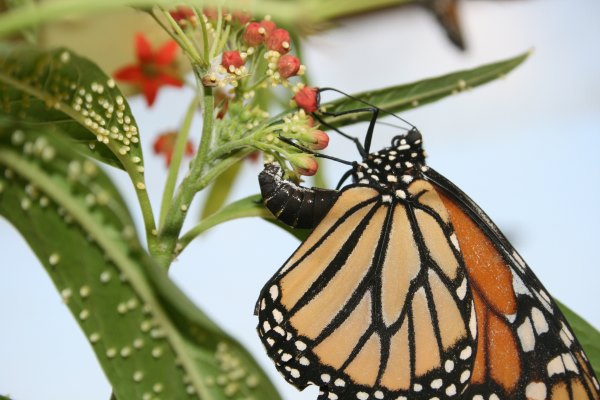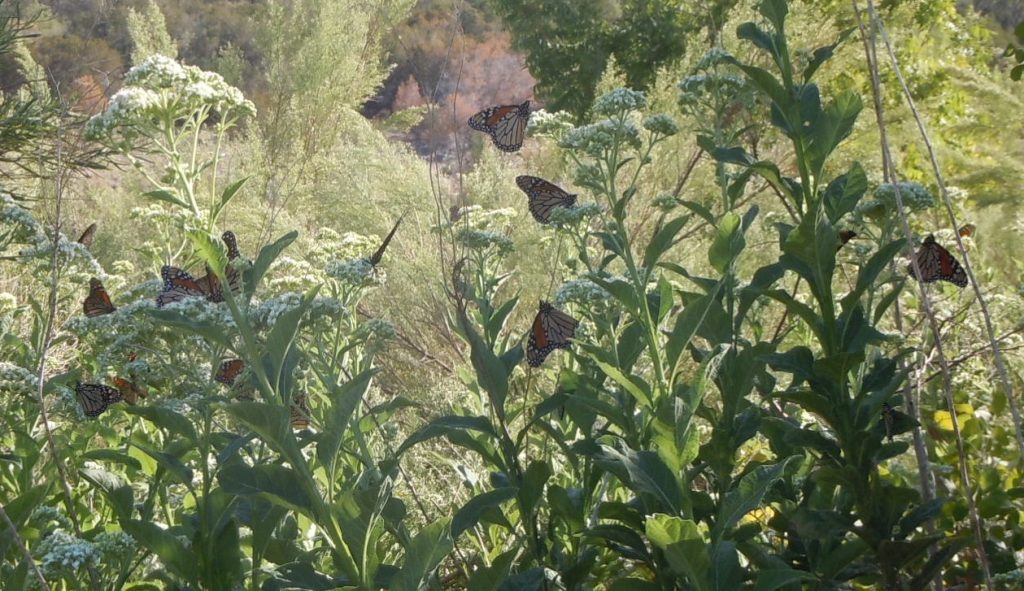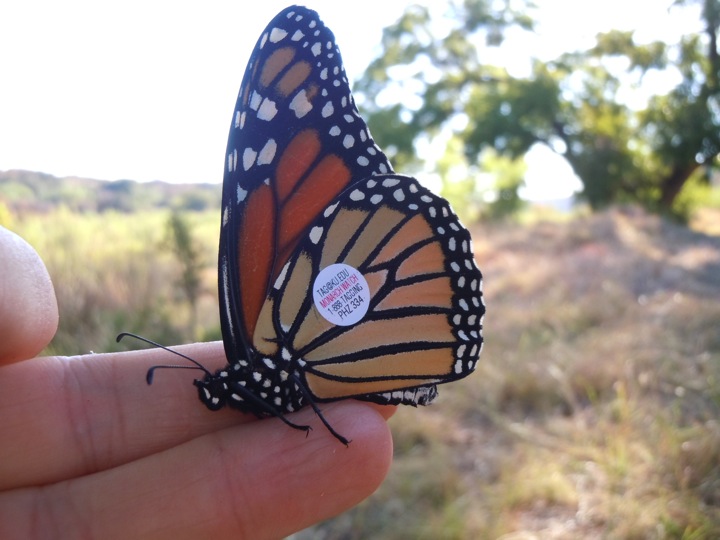What a difference a year makes.
At the end of 2014, we were hanging our heads contemplating the end of the Monarch butterfly migration. The 2013 -2014 season was the worst in history, with roosting populations numbering the lowest since records have been kept. The entire Monarch breeding population had fallen from highs of more than half a billion 20 years ago to only 34 million in 2014.

Dr. Chip Taylor released an upbeat revision to his Monarch population status report based on increased egg laying in the summer breeding grounds. Photo of captive Monarch in egg-laying mode. Courtesy Edith Smith
But then in February of this year, scientists reported a bit of rebound. The population of roosting Monarchs climbed to about 56 million. Still a long way from its peak, but progress. NOTE: For those unaware, scientists measure the number of hectares Monarch butterflies occupy at the roosting sights in Michoacán, Mexico, each winter to calculate their population. Each hectar (about 2.5 acres) occupied represents 50 million butterflies.
The good news continues. On August 6, Dr. Chip Taylor released an upbeat Monarch population status report, based on robust egg laying in the Dakotas to Michigan this summer. “I’m encouraged by the egg data,” Dr. Taylor wrote on August 6. “The size of the migration is strongly influenced by the number of eggs laid between 20 July and 7 August.”
Taylor revised a previous forecast upward, stating the population might jump to occupy 1.8 – 2.3 hectares in Michoacán. That would translate to 90 – 115 million Monarchs–continuing the rebound and doubling 2014’s numbers.

Late summer rains will help sustain nectar sources for migrating Monarch butterflies, like these nectaring on Frostweed on the Llano River in 2013. Photo by Monika Maeckle
The weather and political climate both seem to be cooperating. Texas, home to the “Texas funnel” through which all migrating Monarchs pass each spring and fall on their way from and to their roosting spots, has had a delightfully wet spring and relatively mild summer. An end-of summer dry spell has been broken by periodic thunderstorms that can hopefully keep nectar sources viable for Monarchs when they cruise through the strategically situated Texas Hill Country later this season.
The drought has seen relief and meteorologists are predicting a “Godzilla el Niño” this winter, which conceivably could return our rivers and springs to their former free-flowing status.
On the public awareness front, concern, understanding and resources directed at the Monarch butterfly migration and pollinator advocacy have never been stronger or more dedicated.
President Obama used his office to call attention to pollinators with his visit to Toluca, Mexico in February of 2014, where he and the Presidents of Canada and Mexico vowed to protect the Pan-American Monarch migration. Two months later, First Lady Michelle Obama planted the first pollinator garden at the White house. In June of 2014, Obama issued a Presidential memorandum calling for a National Pollinator Strategy, which was delivered in May of 2015. The goals of the strategy are ambitious and far-reaching:
1. Reduce Honey bee colony losses by more than 15% within 10 years.
2. Increase the migrating Monarch butterfly population to 225 million (their historic average), with an occupation of 15 acres in Michoacán by 2020.
3. Restore or enhance seven million acres of pollinator habitat over the next five years.
Just in the last 18 months, millions of dollars have poured into Monarch butterfly and pollinator research and restoration efforts–from US Fish and Wildlife Service, National Fish and Wildlife Foundation, US Department of Agriculture–even the Texas State Comptroller’s office. As one federal employee stated, “Every department of the federal government has been tasked to contribute [to Monarch conservation] in some way.” Monsanto Corporation, oft-vilified makers of Round-Up and neonicinitoids, has contributed millions to research–more than $4 million in matching grants and other support over three years.
Here’s just a 2015 sampling of Monsanto’s and your tax dollars at work on behalf of Monarch and pollinator restoration:
US Fish and Wildlife Service $2 million
Texas State Comptroller’s Office $300,000
National Fish and Wildlife Fdn. $1 million
Bureau of Land Management $250,000
US Dept. of Agriculture National $250,000
Resource Conservation Svce.
US Forest Service $100,000
Monsanto Corporation $4 million
Thanks to all the newfound attention and investment–about $8 million from the incomplete list above–butterfly and pollinator advocates have been able to partake in a free webinar series on Monarch conservation staged by US Fish and Wildlife. Private landowners (including yours truly) have the option to work with the federal government to be reimbursed for pollinator improvements on private land throught the Partners for Wildlife program. And greater understanding of milkweed types and Monarch diseases is resulting from work being done at Monarch Watch, the Monarch Joint Venture, Journey North, and the recently established Monarch Conservation Fund as well as higher learning institutions like University of Texas at San Antonio.
Regional educational conferences like the upcoming Texas Pollinator Powwow are also reaching new audiences, taking pollinators mainstream. The private sector is also responding. From mega grower Colorspot Nursery to boutiques like the Natural Gardener in Austin–which had five different native milkweeds available last weekend–nurseries are offering more clean, chemical free milkweeds and other pollinator plants to the gardening public.

Monarch butterflies are on the move. Should be a banner year. Get your tags soon from Monarch Watch. Photo by Monika Maeckle
While the millions being directed to pollinator conservation are minuscule compared to the billions directed to farm subsidies each year, it’s still good news and more than has ever been focused on the issue. We expect more as the grants mentioned above are executed, more data is collected and ways of restoring our native landscapes and milkweed stocks are researched and shared. Whether or not the Monarch butterfly migration will continue as a natural phenomenon to be enjoyed by our grandchildren is an open question.
Related posts:
- IH35 to Become Pollinator Corridor for Bees, Monarch Butterflies and Other Pollinators
- Endangered Species Act: Wrong tool for the Job of Monarch butterfly Conservation?
- Tropical milkweed: Ok for Monarch Butterflies, “Just Cut the Dang Stuff Down”
- Wildly Successful: Pollinator Powwow Draws Hundreds from Texas and Beyond
- Monarch Butterfly Numbers Plummet: will Migration become Extinct?
- NAFTA Leaders, Monsanto: Let’s Save the Monarch Butterfly Migration
- UTSA Gets $300K Grant to Inventory Texas Milkweeds, Study Monarch Butterflies
- First Lady Michelle Obama Plants First Pollinator Garden at White House
- Megagrower Colorspot to Grow Clean, Chemical-free Milkweed
Like what you’re reading? Follow butterfly and native plant news at the Texas Butterfly Ranch. Sign up for email delivery, like us on Facebook, or follow us on Twitter, @monikam.


Monica, your article touts the “robust egg laying in the Midwestern breeding grounds this summer”. Yet this Minneapolis tribune article http://tinyurl.com/pc38dyx claimed: “milkweed has all but disappeared from Midwestern landscapes”. If your article is correct then where, specifically, in the upper midwest has this “robust egg laying” been occuring this past summer? This blog http://monarchwatch.org/blog/ said the “Dakotas to Michigan” region, but likewise didn’t specify where, in that vast region, large amounts of milkweed still occur.
Hmm. Taylor said “Dakotas to Michigan” so probably should have said “upper midwest.” Will make the change. –MM
By “where” I meant what types of habitats are large amounts of milkweed still present in the “Dakotas to Michigan” region that will give rise to this season’s “banner” numbers of fall migrant monarchs?
My husband was driving a lot for work last summer, and said that the highways here in northern Minnesota were bordered by very large stands of milkweed. In the fall there were blooming asters and other nectar plants as well stretching for miles and miles. Some of these large stretches of milkweed were along I-35, and some were on the smaller state and county roads. This isn’t a definitive answer to your question, just one piece.
Here are three videos I shot yesturday and today that show the monarchs are abundant right now in south-central Minnesota: https://www.youtube.com/watch?v=OoPdnTepKok
https://www.youtube.com/watch?v=mjhDPnobDSU
https://www.youtube.com/watch?v=9VOHjmY05BE
This is heartening to read, but two things trouble me. One is that the article doesn’t seem to mention how the chopping down of of the monarchs’ overwintering trees Mexico is being dealt with. If that activity continues, I don’t see how all the milkweed plants in the world will have much lasting beneficial effect on the monarch migration.
The other thing that troubles me is what appears to be the sheer number of eggs on the individual milkweed leaves in the photo. Unless there are at least a dozen milkweed plants near them that are “eggless,” I can’t fathom how there’s going to be enough leaves to feed all these caterpillars. That there would be so many eggs makes me wonder if there is indeed a paucity of milkweed plants for the monarchs.
Tay, the photo is by Edith Smith, a professional butterfly breeder. It’s not in the wild. Was just illustrating an abundance of eggs, plus it’s an amazing photo. Sorry for any misunderstanding. –MM
Thanks, Monika!
We tagged our first Monarch today 8/27/15. We have gathered 130 caterpillars so far and it looks like a really great year coming up. Sure great to see the population growing and cooperation from so many agencies especially the maker of Roundup!